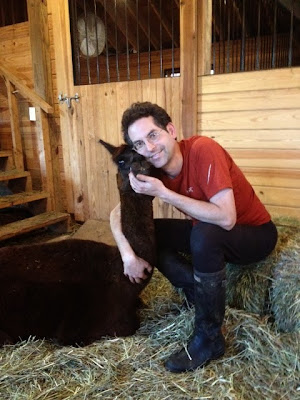One weekend each month, Kathy and I do "care management" and "population health" for the 100 animals of Unity Farm. Here's the workflow:
Llamas/Alpacas
We gently halter each animal and reassure them by rubbing their chins and scratching their ears. After a year with us, we've gained their trust. Many of the animals nuzzle and tuck their heads into our necks, as if to say "Dad, do I really have to go to the doctor?". We then lead each one to the floor scale where we weigh them, looking for monthly variation. Do they have an infection or parasitic issue that is causing weight loss? Have they been eating too much, putting on too much weight? There is no "body mass index" for camelids, so we assess their body score, which is a measure of fat thickness in the hindquarters. After weighing, we subcutaneously inject Ivermectin to prevent meningeal worm (transmitted from deer to alpaca via snails ingested accidentally from grass). Then we trim toenails. Orchid, our guard llama, weighs 317 pounds. Imagine trimming the nails on a 317 pound two year old. We reassure each animal, then explain what we are about to do by saying "foot". I support their body weight with my legs and gently raise each foot to trim the nails, repair any cracked nails, and clear each foot pad of mud and debris. Finally, we check ears and eyes to ensure there are no signs of infection or trauma. We do this for 12 animals in about 3 hours. Once a year at shearing time we also file their teeth if needed.
Chickens/Guinea Fowl
We examine each bird for signs of parasitic infections (loss of feathers or weight), trauma from "hen-pecking", irritation from egg laying, skin damage from cold exposure, and orthopedic injuries from running free range throughout the farm property. We ensure they have a source of grit for digestion and calcium for strong egg shells. We clean their coop thoroughly, scrubbing their water sources and removing any droppings from roosting areas.
Ducks
We examine their web feet for irritation, their feathers for parasites, and their eyes for any signs of infection. We scrape out their pen and freshen the sand/gravel. We replace the straw in their duck house and scrub all their water sources, including their stock pond.
Dogs
We examine their entire bodies for ticks, hot spots, signs of cold damage, trauma from rough play, and their dental health. They are fully vaccinated for Leptospirosis, Coronavirus, Lyme, and Rabies.
Rabbits
Just as with the other animals, we look for signs of weight loss, dermatologic issues, and eye infections. We feed papaya enzyme tablets to reduce hairballs.
2013 has been a great year for the animals. We lost one chicken from a hawk attack and one rabbit from old age. We hope that Unity Farm has created the same stress free environment for the animals that it has for us.
Subscribe to:
Post Comments (Atom)



2 comments:
Why do you raise rabbits?
My daughter has volunteered at an animal shelter for the past 10 years. She rescued two abandoned rabbits many years ago and they have lived with the chickens since we moved to Unity Farm. We do not specifically raise rabbits, they're just living their retirement years with us.
Post a Comment